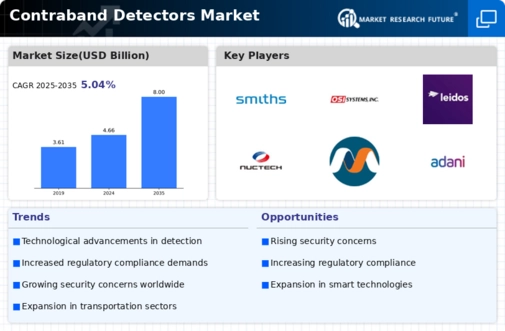Top Industry Leaders in the Contraband Detectors Market

The Competitive Landscape of the Contraband Detectors Market
In the constant battle against unlawful activity, contraband detectors act as vigilant sentinels, safeguarding borders, securing critical infrastructure, and ensuring public safety. From humble X-ray machines to cutting-edge AI-powered scanners, these technological guardians scan, sniff, and sense, unearthing hidden threats across diverse realms. To navigate this dynamic market, where security meets innovation, understanding the competitive landscape, adopted strategies, key players, and emerging trends is essential for both established and aspiring participants.
Some of the Contraband Detectors companies listed below:
- Smith’s Group
- OSI Systems
- Leidos
- Nuctech
- Metrasens
- Adani Systems
- Berkeley Varitronics Systems
- CEIA
- CSECO
- Godrej Security Solutions
Strategies Adopted by Leaders:
- Embracing Innovation and Cutting-Edge Technologies: Investing in R&D to integrate advancements like AI-powered image analysis, advanced material detection sensors, biometrics identification, and remote monitoring capabilities differentiates solutions and caters to the need for enhanced security against increasingly sophisticated threats.
- Prioritizing User Experience and Training: Providing intuitive interfaces, user-friendly software, and comprehensive training programs for operators ensures efficient utilization of the detectors and maximizes their effectiveness.
- Collaboration and Ecosystem Building: Partnering with research institutions, technology providers, security agencies, and system integrators expands knowledge base, fosters innovation, and facilitates broader adoption of solutions.
- Focus on Data Security and Privacy: Implementing robust data security protocols, ensuring user privacy compliance, and transparent data management practices are crucial for building trust and mitigating concerns about misuse and surveillance.
- Sustainability and Environmental Considerations: Utilizing energy-efficient components, minimizing resource consumption in production processes, and offering compliant packaging cater to the growing demand for environmentally responsible solutions within the security sector.
Factors for Market Share Analysis:
- Product Portfolio and Technological Breadth: The range and sophistication of detection solutions offered, encompassing diverse technologies like X-ray scanners, metal detectors, explosives and narcotics sensors, biological agent detectors, and AI-powered analysis software, significantly impact market reach. Catering to specific applications, such as airport security, border control, law enforcement, or maritime security, demands tailored solutions and partnerships.
- Target Market Focus: Focusing on specific segments within the security ecosystem, such as government agencies, airports and airlines, transportation companies, logistics and shipping industries, or private security firms, requires customized marketing strategies and technical specifications addressing their unique needs. Solidifying market share hinges on understanding these sector-specific concerns.
- Accuracy and Reliability: False positives and missed detections can have significant consequences. Ensuring high accuracy, minimizing false alarms, and demonstrating reliable performance throughout operational life are paramount for building trust and market reputation.
- Ease of Use and Integration: User-friendly interfaces, comprehensive training programs, and seamless integration with existing security systems and data platforms enhance operational efficiency and adoption.
- Scalability and Adaptability: Offering modular configurations, customizable detection algorithms, and upgradeable components enables flexibility to adapt to evolving threats and changing security needs across diverse environments.
New and Emerging Companies:
- Niche-Focused Specialists: Companies like ChemImage Corporation and Metrasens specialize in developing advanced chemical and biological agent detection systems, offering unparalleled expertise and targeted solutions for high-security environments or bioterrorism prevention.
- Software-Centric Platforms: Companies like VOTI Detection and Deepwatch Technologies focus on developing AI-powered image and data analysis platforms that can be integrated with existing detector systems, boosting their accuracy and efficiency.
- Open-Source Hardware Advocates: Companies like Open Detectors Project and Hack Defense promote open-source detector designs and readily available hardware kits, empowering researchers and DIY enthusiasts with customization options and fostering innovation within the community.
Latest Company Updates:
Nov. 14, 2023, at Milipol PARIS, ODSecurity exhibited its total contraband detection capability, including Soter RS full body scanner, THEIA automatic threat recognition software, and Central Database.
Sept. 15, 2023, Walaris (USA), a leading developer of autonomous EO/IR-based drone detection, tracking, and identification systems, announced the development of AI-assisted drone detection systems to help prevent smuggling contraband into prisons. The new drone detection system uses machine vision AI tools to fight prison contraband smuggling.
Jan. 30, 2023, RaySecur, a leading provider of desktop T-ray imaging scanners, announced advances in the safety and accessibility of mail-based drug and contraband detection for the corrections market. Enhancements for inmate mail security are designed to make it easier to detect drugs and contraband smuggled into corrections facilities via postal mail without opening it.
Apr. 09, 2021, India announced the development of the world's first micro-sensor-based explosive trace detector (ETD) using a micro-electromechanical system (MEMS). The ETD, called NanoSniffer, provides trace detection of the nano-gram quantity of explosives and delivers results in seconds. Given the constant threats faced by the nation due to geo-political realities, explosives and contraband detection have become a norm at high-security locations like railways & metro stations, airports, hotels, malls, and other public places in India.
Nov.02, 2020, ETH Zurich researchers announced the development of new lasers that can fire terahertz beams, enhancing medical imaging and contraband detection. The new semiconductor lasers can work with small, portable coolers to enable applications outside laboratories. These lasers could enable new portable medical diagnostics and explosive detectors.
